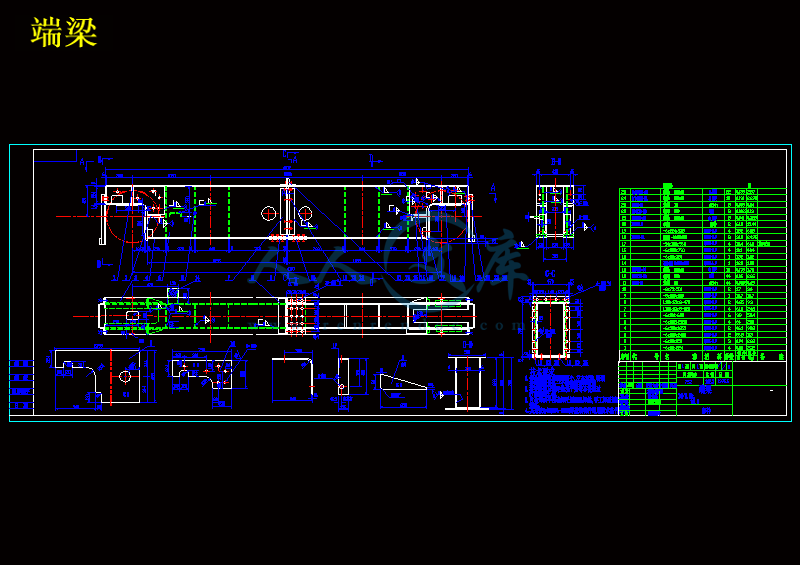QD型16-3.2T电动桥式双梁起重机的机械设计【6张CAD图纸和说明书】
收藏
资源目录

压缩包内文档预览:
编号:10400473
类型:共享资源
大小:2.97MB
格式:RAR
上传时间:2018-08-08
上传人:俊****计
认证信息
个人认证
束**(实名认证)
江苏
IP属地:江苏
40
积分
- 关 键 词:
-
qd
16
电动
桥式双梁
起重机
机械设计
cad
图纸
以及
说明书
仿单
- 资源描述:
-
1. 绪论 1
1.1 选题的意义: 1
1.2 起重机的发展概况: 1
2. 16/3.2T 电动桥式起重机主起升机构的设计 2
2.1 钢丝绳的选择 2
2.1.1 钢丝绳受到静拉力的计算 2
2.1.2 钢丝绳型号选择 2
2.1.3 滑轮组选择 3
2.2 卷筒的选择 3
2.2.1 卷筒直径选择 3
2.2.2 卷筒长度 3
2.2.3 卷筒的转速计算 3
2.3 选择电动机 4
2.3.1 电动机静功率的计算 4
2.3.2 电动机功率 4
2.3.3 电动机过载能力校验 4
2.4 减速器的选择 4
2.4.1 传动比的计算 4
2.4.2 标准减速器的选择 4
2.4.3. 验算减速器 5
2.5 选择制动器 5
2.6 选择轴及联轴器 5
2.6.1 轴的选择: 5
2.6.2 联轴器的的选择 6
2.7 起动及制动时间验算 6
2.7.1 起动时间和起动加速度验算 6
2.7.2 制动时间和制动平均加速度验算 7
3. 16/3.2T 电动桥式起重机副起升机构的设计 7
4 电动小车运行机构的设计 8
4.1 运行阻力的计算 8
4.1.1 摩擦力Fm的计算 8
4.1.2坡道力Fp的计算 8
4.1.3 运行风阻力Fw 8
4.2 电动机的选择 8
4.2.1 电动机的静功率的计算 8
4.2.2 电动机的初选 9
4.3 起动时间与起动平均加速度的验算。 10
4.4 标准减速器的选择 10
4.5 制动器的选择 11
4.6 传动轴和联轴器的选择 11
4.7 运行打滑验算 12
5 大车运行机构的设计 12
6 双梁小车式桥式起重机金属结构设计 13
6.1 载荷的计算 13
计算得: 所以轮压分布如图4所示; 13
6.2 主梁的结构及尺寸选择 14
6.2.1 按梁的强度条件确定梁高hs 14
6.3 主梁设计计算。 15
6.3.2 主梁的刚度计算 16
结束语 17
致谢 17
主要参考文献与资料 18
1. 绪论
1.1 选题的意义:
在现代工业化的社会里,起重机在我们生活的方方面面都能用到,从港口的装卸港机到建筑上的建筑塔吊,从车间的行车到汽车试吊车。解决了我们过去的人力抬作,完成着过去所不能完成的任务。处处为人类的制造的进步作贡献。最常用的通用起重机承担着生产车间许多,许多方面的基础工作,为工业高效生产提供保证。 在这个全球经济危机的大的背景下,起重行业受到了严峻的挑战,竞争更加激烈。那么更合理的,更先进的制造起重机,以最优性价比来赢得市场。那么,为了赢得挑战,选择了起重机的机械部分设计。
1.2 起重机的发展概况:
我国的起重机行业是从建国后开始建设,多部分是采用苏联标准。改革开放以后,随着我国的工业迅速发展,各行工业起重机的要求也随之提高。作为特种设备,检验也要求相对严格。国家也逐步形成了一定制造,检验标准。电气设备也随着不同的要求而改变。有传统的接触器控制,也逐步向自动化方面发展。随着变频器,可编程控制器(PLG)的技术成熟,也被广泛应用在起重机当中。为了起重机方面操作人员的安全,无线远程控制也逐渐普及。为了,满足高精度,多速度行车的需要,机械部分要求也越来越高,设计更精确,
钢丝绳起重机作为一种大型起重设备,广泛用于国民经济各个领域,而国内钢丝绳起重机近几年的发展却十分缓慢。上世纪60年代到70年代初,我国从前苏联引进了TV型钢丝绳式起重机。其间,曾有一些厂家引进国外先进的生产制造技术, 但均未获得广泛的推广应用。
桥式起重机的现状:桥式起重机是作为生产车间最常用的基础设备,也是在各类起重机中,需求量最大的。一般桥式起重机有以下几部分组成。有起升机构,小车运行机构,大车运行机构,控制电路,金属框架结构等主要机构组成。在现在的桥式起重机机械制造中,还是传统的用大的钢构成本,还有沉重的运行机构,来超大的满足需要,在制造工艺中还存在着种种问题,对于材料有很多的浪费情况,为了极大的节省成本,故要精确的计算受力及选择配件。在原有的基础上进行改进,符合实际工作场合。







- 内容简介:
-
Crane Work Needs More T 马棚网 Crane Work Needs More TechniqueAbstractCrane work needs more technology. Construction of tower cranes are the main vertical transportation equipment and also a measure of construction companies and equipment strength of the important logo, in todays increasingly competitive construction market, to meet the construction needs of many construction companies have bought the tower crane. With the tower crane at the construction site of the widely used by the tower crane accident also caused more and more to peoples lives and property brought about great losses. According to national statistics, the departments concerned, the tower crane accident rate reached 2.77 percent. Its security problem is still the urgency of the construction Loose training, testing and oversight requirements for the people who work around construction cranes have fostered a false sense of security in our industry. The recent deadly tower-crane collapse at a congested New YorkCity building site should be a wake-up call for us to question and step up our current safety practices.Training and testing is king when it comes to safety. But the construction industry is putting unqualified personnel in the seats of construction cranes, even with todays testing. In many places, no experience is necessary after passing a standardized test. One week of study will give some people enough knowledge to pass a certification examination, and then they can jump into the cab of a crane.Imagine that a commercial airline pilot had the same training as a certified crane operator. How would you feel the next time you decided to fly? In California, it takes more hours of training to wield a pair of scissors in a hair salon than to operate potentially dangerous lifting machinery. How does this make sense?Riggers and signal persons also need standard training and testing to ensure safety under the hook. Employers usually allow any craft to signal a crane on a jobsite, despite best practices that require only qualified people do so. How is it then that uncertified and untrained people are allowed to signal and rig under the hook of a licensed or certified operator?Tower cranes are particularly risky as urban sites become more congested, and the risk of a catastrophic event is very high during climbing operations. Yet most tower-crane climbing crews are trained in a non-traditional manner, via secondhand knowledge that has been passed down over time. The problem with this type of hand-me-down knowledge is that it changes over the years, leaving out small-but-important details along the way. This “osmosis“ of knowledge leads crews to develop their own tricks for climbing cranes, often forsaking basic safety in an attempt to save time and energy.In many cases, there are no safety devices or alarms to warn of a serious problem. Climbing crews are subjected to pressures that affect safety-critical decision-making. It is not uncommon for climbs to continue with damaged or leaking hydraulic systems, out-of-adjustment or jammed guide rollers, often working in the dark and for extended hours. This “MacGyver“ method of climbing, where every jump becomes a new adventure, should not be the norm. Climbing-frame designs vary among manufacturers, but the operational steps are similar in principle. The climbing process is relatively straightforward, with a mixture of physical work and technical procedure. It is not complex; it is more about knowing the proper sequence of what needs to be done and then following the steps, one by one, making sure each step has been successfully completed before moving onto the next. It is essential that everyone know exactly what is going on and what the dangers are at every stage.Thats why the industry needs standardized training, testing and oversight for this work, including a practical assessment of competence. Technicians should have model-specific training directly from the manufacturer, along with a level of practical experience. Inspectors, too, should be required to have specific technical training. They should be independent from all aspects of installation and maintenance to allow for objective decisions. Key personnel on erection crews should have standard training and testing.When these needs are satisfied, crane operations should be carried out in strict accordance with the manufacturers instructions, engineering principals and governmental laws. But industry stakeholders and lawmakers need to step up their lax standards to protect the public. New York City residents, who have seen their homes turned into dust and debris, would be shocked at the way the industry deals with these issues.起重机的工作需要更多的科学技术摘要塔式起重机是建筑施工垂直运输的主要设备,也是衡量一个建筑施工企业装备实力的重要标识,在当今竞争日益激烈的建筑市场,为满足施工需要,很多施工企业都购置了塔式起重机。随着塔式起重机在施工现场的广泛使用,由塔式起重机引发的伤亡事故也越来越多,给人民的生命财产带来重大损失。据国内有关部门统计资料表明,塔式起重机的事故率已达 2.77%。其安全问题仍然是建筑施工中的忧患起重机的工作需要更多的科学技术松散的培训,测试和监督的要求, 周围的建筑起重机给这些工作的人树立了一种虚假的安全感,在我们的行业。最近塔式起重机倒塌在一个繁忙的纽约市建筑地盘应敲响警钟,提醒我们问题的存在,并加强我们目前安全的做法。当谈到安全问题时,训练和测试是关键。不过,建造业是把不合格人员放在建筑起重机的驾驶位上,甚至没有通过今天的测试。在许多地方,没有任何经验必须合格的通过标准化的测试。一周的学习将给予一些人足够的知识足以通过认证考试,然后他们可以跳转到的起重机的驾驶室。想象一下一个商业航空公司飞行员和一个认证的起重机操作员有相同的训练。你会如何感觉,下一次你决定要坐飞机?在加利福尼亚州,掌握一对剪刀在头发沙龙比操作有潜在危险的起重机械需要更多的时间训练。如何,这是否合理?装配工人和发信号的人也需要标准的培训和测试,以确保安全下钩。雇主通常允许任何工人发信号指挥起重机上工地 ,尽管最佳做法是需要合格的人这样做。怎么能允许那么无证和未受过训练的人来代替有工作证或经核证的操作者呢? 塔式起重机是特别危险的,尤其是在市区用地变得更加拥挤时。攀登行动更是一个风险的行动,其灾难性非常高。然而,大多数塔式起重机攀登员的训练,在一个非传统的方式,通过二手知识已流传一段时间。问题与这种类型的现成的知识是,多年来,留下来
- 温馨提示:
1: 本站所有资源如无特殊说明,都需要本地电脑安装OFFICE2007和PDF阅读器。图纸软件为CAD,CAXA,PROE,UG,SolidWorks等.压缩文件请下载最新的WinRAR软件解压。
2: 本站的文档不包含任何第三方提供的附件图纸等,如果需要附件,请联系上传者。文件的所有权益归上传用户所有。
3.本站RAR压缩包中若带图纸,网页内容里面会有图纸预览,若没有图纸预览就没有图纸。
4. 未经权益所有人同意不得将文件中的内容挪作商业或盈利用途。
5. 人人文库网仅提供信息存储空间,仅对用户上传内容的表现方式做保护处理,对用户上传分享的文档内容本身不做任何修改或编辑,并不能对任何下载内容负责。
6. 下载文件中如有侵权或不适当内容,请与我们联系,我们立即纠正。
7. 本站不保证下载资源的准确性、安全性和完整性, 同时也不承担用户因使用这些下载资源对自己和他人造成任何形式的伤害或损失。

人人文库网所有资源均是用户自行上传分享,仅供网友学习交流,未经上传用户书面授权,请勿作他用。
 川公网安备: 51019002004831号
川公网安备: 51019002004831号